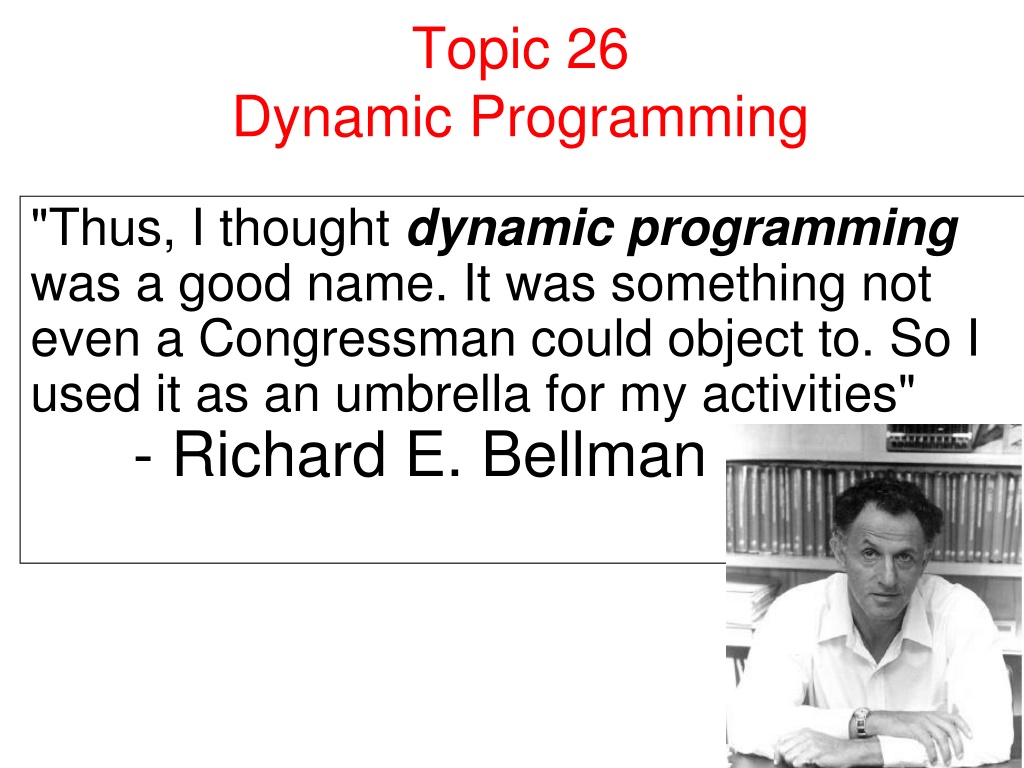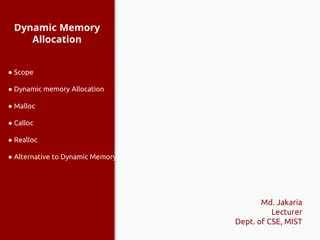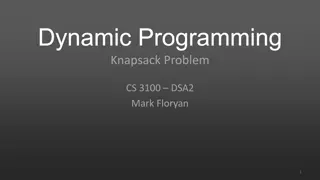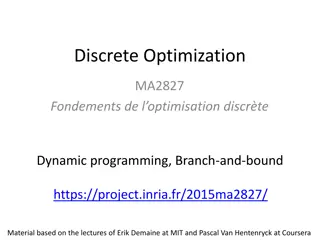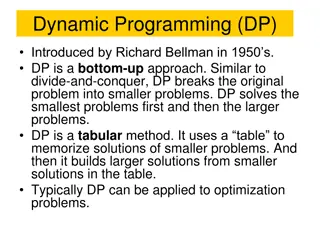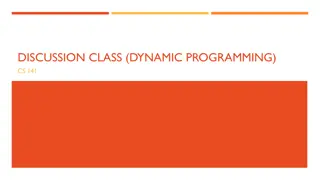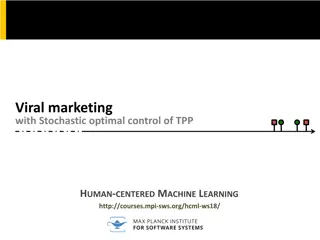Understanding Dynamic Programming through Richard Bellman's Insights
Dynamic Programming, as coined by mathematician Richard Bellman in the 1950s, is a powerful method for solving complex problems by breaking them into smaller sub-problems. Bellman's innovative approach has had a significant impact on various fields. This article explores the origins, principles, and challenges of dynamic programming, particularly in solving Fibonacci sequences. It also delves into the pitfalls of naive recursive methods and the need for more efficient algorithms.
Download Presentation

Please find below an Image/Link to download the presentation.
The content on the website is provided AS IS for your information and personal use only. It may not be sold, licensed, or shared on other websites without obtaining consent from the author. Download presentation by click this link. If you encounter any issues during the download, it is possible that the publisher has removed the file from their server.
E N D
Presentation Transcript
Topic 26 Dynamic Programming "Thus, I thought dynamic programming was a good name. It was something not even a Congressman could object to. So I used it as an umbrella for my activities" - Richard E. Bellman
Origins A method for solving complex problems by breaking them into smaller, easier, sub problems Term Dynamic Programming coined by mathematician Richard Bellman in early 1950s employed by Rand Corporation Rand had many, large military contracts Secretary of Defense, Charles Wilson against research, especially mathematical research how could any one oppose "dynamic"? CS314 Dynamic Programming 2
Dynamic Programming Break big problem up into smaller problems ... Sound familiar? Recursion? N! = 1 for N == 0 N! = N * (N - 1)! for N > 0 CS314 Dynamic Programming 3
Fibonacci Numbers 1, 1, 2, 3, 5, 8, 13, 21, 34, 55, 89, 114, F1 = 1 F2 = 1 FN = FN - 1 + FN - 2 Recursive Solution? CS314 Dynamic Programming 4
Failing Spectacularly Na ve recursive method // pre: n > 0 // post: return the nth Fibonacci number public int fib(int n) { if (n <= 2) return 1; else return fib(n 1) + fib (n 2); } Clicker 1 - Order of this method? A. O(1) B. O(log N) C. O(N) D. O(N2) E. O(2N) CS314 Dynamic Programming 5
Failing Spectacularly CS314 Dynamic Programming 6
Failing Spectacularly CS314 Dynamic Programming 7
Clicker 2 - Failing Spectacularly How long to calculate the 70th Fibonacci Number with this method? A. 37 seconds B. 74 seconds C. 740 seconds D. 14,800 seconds E. None of these CS314 Dynamic Programming 8
Aside - Overflow at 47th Fibonacci number overflows int Could use BigInteger class instead private static final BigInteger one = new BigInteger("1"); private static final BigInteger two = new BigInteger("2"); public static BigInteger fib(BigInteger n) { if (n.compareTo(two) <= 0) return one; else { BigInteger firstTerm = fib(n.subtract(two)); BigInteger secondTerm = fib(n.subtract(one)); return firstTerm.add(secondTerm); } } CS314 Dynamic Programming 9
Aside - BigInteger Answers correct beyond 46th Fibonacci number Even slower, math on BigIntegers, object creation, and garbage collection CS314 Dynamic Programming 10
Slow Fibonacci Why so slow? Algorithm keeps calculating the same value over and over When calculating the 40th Fibonacci number the algorithm calculates the 4th Fibonacci number 24,157,817 times!!! CS314 Dynamic Programming 11
Fast Fibonacci Instead of starting with the big problem and working down to the small problems ... start with the small problem and work up to the big problem public static BigInteger fastFib(int n) { BigInteger smallTerm = one; BigInteger largeTerm = one; for (int i = 3; i <= n; i++) { BigInteger temp = largeTerm; largeTerm = largeTerm.add(smallTerm); smallTerm = temp; } return largeTerm; } CS314 Dynamic Programming 12
Fast Fibonacci CS314 Dynamic Programming 13
Fast Fibonacci CS314 Dynamic Programming 14
Memoization Store (cache) results from computations for later lookup Memoization of Fibonacci Numbers public class FibMemo { private static List<BigInteger> lookupTable; private static final BigInteger ONE = new BigInteger("1"); lookupTable.add(null); lookupTable.add(ONE); lookupTable.add(ONE); } static { lookupTable = new ArrayList<>(); CS314 Dynamic Programming 15
Fibonacci Memoization public static BigInteger fib(int n) { // check lookup table if (n < lookupTable.size()) { return lookupTable.get(n); } // Calculate nth Fibonacci. // Don't repeat work. Start with the last known. BigInteger smallTerm = lookupTable.get(lookupTable.size() - 2); BigInteger largeTerm = lookupTable.get(lookupTable.size() - 1); for(int i = lookupTable.size(); i <= n; i++) { BigInteger temp = largeTerm; largeTerm = largeTerm.add(smallTerm); lookupTable.add(largeTerm); // memo smallTerm = temp; } return largeTerm; }
Dynamic Programming When to use? When a big problem can be broken up into sub problems. Solution to original problem can be calculated from results of smaller problems. larger problems depend on previous solutions Sub problems must have a natural ordering from smallest to largest (simplest to hardest) Multiple techniques within DP CS314 Dynamic Programming 17
DP Algorithms Step 1: Define the *meaning* of the subproblems (in English for sure, Mathematically as well if you find it helpful). Step 2: Show where the solution will be found. Step 3: Show how to set the first subproblem. Step 4: Define the order in which the subproblems are solved. Step 5: Show how to compute the answer to each subproblem using the previously computed subproblems. (This step is typically polynomial, once the other subproblems are solved.) CS314 Dynamic Programming 18
Dynamic Programming Requires: overlapping sub problems: problem can be broken down into sub problems obvious with Fibonacci Fib(N) = Fib(N - 2) + Fib(N - 1) for N >= 3 optimal substructure: the optimal solution for a problem can be constructed from optimal solutions of its sub problems In Fibonacci just sub problems, no optimality min coins opt(36) = 112 + opt(24) [1, 5, 12] CS314 Dynamic Programming 19
Dynamic Programing Example Another simple example Finding the best solution involves finding the best answer to simpler problems Given a set of coins with values (V1, V2, VN) and a target sum S, find the fewest coins required to equal S What is Greedy Algorithm approach? Does it always work? {1, 5, 12} and target sum = 15 (12, 1, 1, 1) Could use recursive backtracking CS314 Dynamic Programming 20
Minimum Number of Coins To find minimum number of coins to sum to 15 with values {1, 5, 12} start with sum 0 recursive backtracking would likely start with 15 Let M(S) = minimum number of coins to sum to S At each step look at target sum, coins available, and previous sums pick the smallest option CS314 Dynamic Programming 21
Minimum Number of Coins M(0) = 0 coins M(1) = 1 coin (1 coin) M(2) = 2 coins (1 coin + M(1)) M(3) = 3 coins (1 coin + M(2)) M(4) = 4 coins (1 coin + M(3)) M(5) = interesting, 2 options available: 1 + others OR single 5 if 1 then 1 + M(4) = 5, if 5 then 1 + M(0) = 1 clearly better to pick the coin worth 5 CS314 Dynamic Programming 22
Minimum Number of Coins M(0) = 0 M(1) = 1 (1 coin) M(2) = 2 (1 coin + M(1)) M(3) = 3 (1 coin + M(2)) M(4) = 4 (1 coin + M(3)) M(5) = 1 (1 coin + M(0)) M(6) = 2 (1 coin + M(5)) M(7) = 3 (1 coin + M(6)) M(8) = 4 (1 coin + M(7)) M(9) = 5 (1 coin + M(8)) M(10) = 2 (1 coin + M(5)) options: 1, 5 M(11) = 2 (1 coin + M(10)) options: 1, 5 M(12) = 1 (1 coin + M(0)) options: 1, 5, 12 M(13) = 2 (1 coin + M(12)) options: 1, 12 M(14) = 3 (1 coin + M(13)) options: 1, 12 M(15) = 3 (1 coin + M(10)) options: 1, 5, 12 CS314 Dynamic Programming 23
KNAPSACK PROBLEM - RECURSIVE BACKTRACKING AND DYNAMIC PROGRAMMING CS314 Dynamic Programming 24
Knapsack Problem A variation of a bin packing problem Similar to fair teams problem from recursion assignment You have a set of items Each item has a weight and a value You have a knapsack with a weight limit Goal: Maximize the value of the items you put in the knapsack without exceeding the weight limit CS314 Dynamic Programming 25
Knapsack Example Items: Item Number Weight of Item Value of Item Value per unit Weight 6.0 5.5 0.25 3.0 3.167 1.714 1 2 3 4 5 6 1 2 4 4 6 7 6 11 1 12 19 12 Weight Limit = 8 One greedy solution: Take the highest ratio item that will fit: (1, 6), (2, 11), and (4, 12) Total value = 6 + 11 + 12 = 29 Clicker 3 - Is this optimal? A. No B. Yes
Knapsack - Recursive Backtracking private static int knapsack(ArrayList<Item> items, int current, int capacity) { int result = 0; if (current < items.size()) { // don't use item int withoutItem = knapsack(items, current + 1, capacity); int withItem = 0; // if current item will fit, try it Item currentItem = items.get(current); if (currentItem.weight <= capacity) { withItem += currentItem.value; withItem += knapsack(items, current + 1, capacity - currentItem.weight); } result = Math.max(withoutItem, withItem); } return result; }
Knapsack - Dynamic Programming Recursive backtracking starts with max capacity and makes choice for items: choices are: take the item if it fits don't take the item Dynamic Programming, start with simpler problems Reduce number of items available AND Reduce weight limit on knapsack Creates a 2d array of possibilities CS314 Dynamic Programming 28
Knapsack - Optimal Function OptimalSolution(items, weight) is best solution given a subset of items and a weight limit 2 options: OptimalSolution does not select ith item select best solution for items 1 to i - 1with weight limit of w OptimalSolution selects ith item New weight limit = w - weight of ith item select best solution for items 1 to i - 1with new weight limit 29
Knapsack Optimal Function OptimalSolution(items, weight limit) = 0 if 0 items OptimalSolution(items - 1, weight) if weight of ith item is greater than allowed weight wi > w (In others ith item doesn't fit) max of (OptimalSolution(items - 1, w), value of ith item + OptimalSolution(items - 1, w - wi) CS314 Dynamic Programming 30
Knapsack - Algorithm Create a 2d array to store value of best option given subset of items and possible weights Item Number 1 2 3 4 5 6 Weight of Item 1 2 4 4 6 7 Value of Item 6 11 1 12 19 12 In our example 0 to 6 items and weight limits of of 0 to 8 Fill in table using OptimalSolution Function CS314 Dynamic Programming 31
Knapsack Algorithm Given N items and WeightLimit Create Matrix M with N + 1 rows and WeightLimit + 1 columns For weight = 0 to WeightLimit M[0, w] = 0 For item = 1 to N for weight = 1 to WeightLimit if(weight of ith item > weight) M[item, weight] = M[item - 1, weight] else M[item, weight] = max of M[item - 1, weight] AND value of item + M[item - 1, weight - weight of item]
Knapsack - Table Item Weight Value 1 1 6 2 2 11 3 4 1 4 4 12 5 6 19 6 7 12 items / capacity 0 1 2 3 4 5 6 7 8 {} 0 0 0 0 0 0 0 0 0 {1} {1,2} {1, 2, 3} {1, 2, 3, 4} {1, 2, 3, 4, 5} CS314 {1, 2, 3, 4, 5, 6} Dynamic Programming 33
Knapsack - Completed Table items / weight 0 1 2 3 4 5 6 7 8 {} 0 0 0 0 0 0 0 0 0 {1} [1, 6] {1,2} [2, 11] {1, 2, 3} [4, 1] {1, 2, 3, 4} [4, 12] {1, 2, 3, 4, 5} [6, 19] {1, 2, 3, 4, 5, 6} 0 6 6 6 6 6 6 6 6 0 6 11 17 17 17 17 17 17 0 6 11 17 17 17 17 18 18 0 6 11 17 17 18 23 29 29 0 6 11 17 17 18 23 29 30 0 Dynamic Programming 6 11 17 17 18 23 29 30 CS314 [7, 12] 34
Knapsack - Items to Take items / weight 0 1 2 3 4 5 6 7 8 {} 0 0 0 0 0 0 0 0 0 {1} [1, 6] {1,2} [2, 11] {1, 2, 3} [4, 1] {1, 2, 3, 4} [4, 12] {1, 2, 3, 4, 5} [6, 19] {1, 2, 3, 4, 5, 6} 0 6 6 6 6 6 6 6 6 0 6 11 17 17 17 17 17 17 0 6 11 17 17 17 17 17 17 0 6 11 17 17 18 23 29 29 0 6 11 17 17 18 23 29 30 0 Dynamic Programming 6 11 17 17 18 23 29 30 CS314 [7, 12] 35
Dynamic Knapsack // dynamic programming approach public static int knapsack(ArrayList<Item> items, int maxCapacity) { final int ROWS = items.size() + 1; final int COLS = maxCapacity + 1; int[][] partialSolutions = new int[ROWS][COLS]; // first row and first column all zeros for(int item = 1; item <= items.size(); item++) { for(int capacity = 1; capacity <= maxCapacity; capacity++) { Item currentItem = items.get(item - 1); int bestSoFar = partialSolutions[item - 1][capacity]; if( currentItem.weight <= capacity) { int withItem = currentItem.value; int capLeft = capacity - currentItem.weight; withItem += partialSolutions[item - 1][capLeft]; if (withItem > bestSoFar) { bestSoFar = withItem; } } partialSolutions[item][capacity] = bestSoFar; } } return partialSolutions[ROWS - 1][COLS - 1]; }
Dynamic vs. Recursive Backtracking Timing Data Number of items: 32. Capacity: 123 Recursive knapsack. Answer: 740, time: 10.0268025 Dynamic knapsack. Answer: 740, time: 3.43999E-4 Number of items: 33. Capacity: 210 Recursive knapsack. Answer: 893, time: 23.0677814 Dynamic knapsack. Answer: 893, time: 6.76899E-4 Number of items: 34. Capacity: 173 Recursive knapsack. Answer: 941, time: 89.8400178 Dynamic knapsack. Answer: 941, time: 0.0015702 Number of items: 35. Capacity: 93 Recursive knapsack. Answer: 638, time: 81.0132219 Dynamic knapsack. Answer: 638, time: 2.95601E-4 CS314 Dynamic Programming 37
Clicker 4 Which approach to the knapsack problem uses more memory? A. the recursive backtracking approach B. the dynamic programming approach C. they use about the same amount of memory CS314 Dynamic Programming 38
